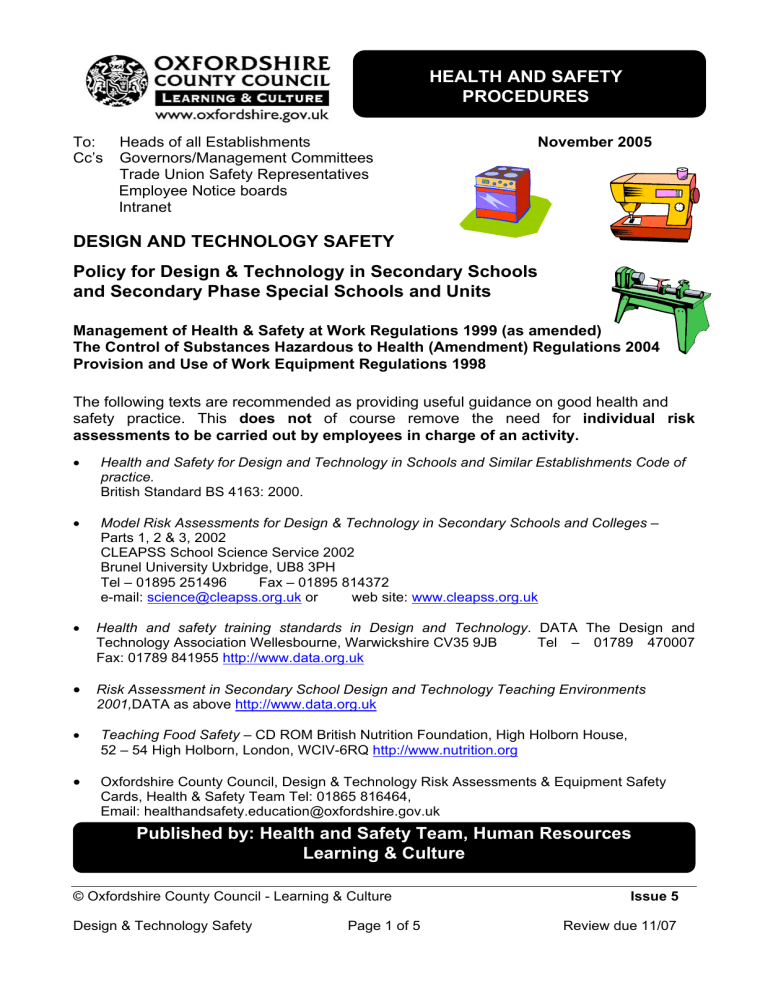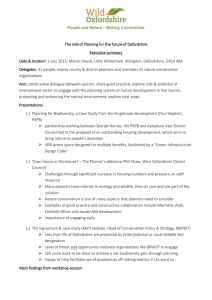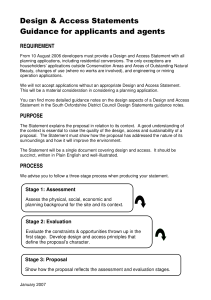Safety policy for secondary schools

HEALTH AND SAFETY
PROCEDURES
To: Heads of all Establishments
Cc’s Governors/Management Committees
Trade Union Safety Representatives
Employee Notice boards
Intranet
DESIGN AND TECHNOLOGY SAFETY
November 2005
Policy for Design & Technology in Secondary Schools and Secondary Phase Special Schools and Units
Management of Health & Safety at Work Regulations 1999 (as amended)
The Control of Substances Hazardous to Health (Amendment) Regulations 2004
Provision and Use of Work Equipment Regulations 1998
The following texts are recommended as providing useful guidance on good health and safety practice. This does not of course remove the need for individual risk assessments to be carried out by employees in charge of an activity.
•
Health and Safety for Design and Technology in Schools and Similar Establishments Code of practice.
British Standard BS 4163: 2000.
•
Model Risk Assessments for Design & Technology in Secondary Schools and Colleges –
Parts 1, 2 & 3, 2002
CLEAPSS School Science Service 2002
Brunel University Uxbridge, UB8 3PH
Tel – 01895 251496 Fax – 01895 814372 e-mail: science@cleapss.org.uk
or web site: www.cleapss.org.uk
•
Health and safety training standards in Design and Technology . DATA The Design and
Technology Association Wellesbourne, Warwickshire CV35 9JB
Fax: 01789 841955 http://www.data.org.uk
Tel – 01789 470007
•
Risk Assessment in Secondary School Design and Technology Teaching Environments
2001, DATA as above http://www.data.org.uk
•
Teaching Food Safety – CD ROM British Nutrition Foundation, High Holborn House,
52 – 54 High Holborn, London, WCIV-6RQ http://www.nutrition.org
•
Oxfordshire County Council, Design & Technology Risk Assessments & Equipment Safety
Cards, Health & Safety Team Tel: 01865 816464,
Email: healthandsafety.education@oxfordshire.gov.uk
Published by: Health and Safety Team, Human Resources
Learning & Culture
© Oxfordshire County Council - Learning & Culture
Design & Technology Safety Page 1 of 5
Issue 5
Review due 11/07
Policy
Areas to be covered include food technology, textile technology, resistant materials, electronics & controls and any other appropriate activities required by Design &
Technology in the National Curriculum.
A statement of policy should include the following as a minimum: -
•
The employees teaching Design & Technology will comply with the school’s safety policy and take account of national recommendations and guidelines.
•
Employees will develop and use safe procedures within all areas of the Design &
Technology department.
•
It is the responsibility of all employees to be aware of potential hazards and act accordingly in order to minimise associated risks.
•
Employees will ensure that risks to health and safety are minimised by vigilance, particularly in respect of procedures and equipment used to teach safe practice and awareness of obvious, presumed and anticipated hazards.
Managers must ensure that suitable and sufficient risk assessments have been made and that SIGNIFICANT FINDINGS are recorded, before STARTING any Design
& Technology activity.
Five Steps to Risk Assessment
Look for the hazards
Decide who might be harmed and how
Evaluate risks and decide whether the existing precautions are adequate or whether more should be done
Record the significant findings
Review the assessment and revise it if necessary
© Oxfordshire County Council - Learning & Culture
Design & Technology Safety Page 2 of 5
Issue 5
Review due 1107
Practice
The Head of the Design and Technology Department must: -
•
Formulate, implement and monitor Design & Technology health and safety policy and procedures.
•
Formulate safe systems of work and inform employees of relevant health and safety regulations.
•
Ensure health and safety matters are a standing item at each departmental meeting.
•
Ensure all employees are properly trained and competent in the activities undertaken in accordance with the OCC / DATA Health & safety training standards in Design &
Technology .
•
All specific Design & Technology training will need to be re validated every 5 years.
(see Oxfordshire County Council Intranet Learning & Culture Resources Health &
Safety Training )
•
Instigate a defect reporting system and act upon information received from employees regarding faulty equipment.
•
Ensure that regular checks of procedures and equipment are carried out before use, and maintained to prescribed standards.
•
Allocate resources within his/her control on matters of health and safety
•
Ensure risk assessments are recorded for hazardous activities.
The Teachers working within a Design & Technology Department must:-
•
Work within the departmental health & safety policy and follow recognised safe working practices.
•
Check the safety and suitability of all tools and equipment.
•
Take all reasonable care of the students in their charge
•
Teach students about the hazards, risks and risk control within Design & Technology as detailed in the “ Teaching Safety ” procedure: http://portal.oxfordshire.gov.uk/content/public/LandC/Resources/healthsafe/t/teachs.pdf
•
Inform the Head of Design & Technology and other employees of known potential hazards and take appropriate action in order to minimise associated risks.
•
Investigate accidents and dangerous occurrences as well as near misses to help prevent reoccurrence and report them to the head of the Design & Technology department as detailed in the “ Reporting of Injuries, Diseases and Dangerous
Occurrences ” procedure: http://portal.oxfordshire.gov.uk/content/public/LandC/Resources/healthsafe/r/riddor.pdf
© Oxfordshire County Council - Learning & Culture
Design & Technology Safety Page 3 of 5
Issue 5
Review due 1107
General Procedures
Specific reference must be made to documents listed on the front cover of this document before Design & Technology activities are undertaken.
Employees and Students
•
All employees and students should understand and adhere to Oxfordshire County
Council health and safety policies / procedures (See Health & Safety Homepage:
Learning & Culture Resources Health & Safety Procedures at all times and make reference to national recommendations and guidelines when appropriate.
•
All employees should ensure that they comply with any specific regulations relating to particular activities and are also competent to perform the activity,
•
Based on suitable and sufficient risk assessments all employees and students must wear appropriate personal protective equipment, clothing and footwear and remove jewellery before participating in any practical work. If jewellery cannot be removed for any reason it must be made safe, (i.e. covered) during the activities. Action may also need to be taken with regard to the hazards associated with long hair.
•
Students must not use tools or equipment unless under direct supervision of a competent person.
•
All accidents to employees and pupils must be reported and appropriate action taken including the completion of an accident report Form AR1 as detailed in the “ Reporting of
Injuries, Diseases and Dangerous Occurrences ” procedure:
http://portal.oxfordshire.gov.uk/content/public/LandC/Resources/healthsafe/r/riddor.pdf
Equipment
•
An independent and competent contractor must inspect and maintain (as necessary), all large items of powered machinery on an annual basis. http://portal.oxfordshire.gov.uk/content/public/LandC/Resources/healthsafe/specifications/
Design_Tech_Specification_2004.pdf
•
Tools and equipment must be inspected regularly, the inspection details recorded and all necessary remedial action taken.
•
Controls measures for dusts, mists, vapours and fumes e.g. Local Exhaust Ventilation
(LEV) must be used at all times, in accordance with the Control of Substances
Hazardous to Health Regulations (COSHH) (See “ Control of Substances Hazardous to
Health ” procedure): http://portal.oxfordshire.gov.uk/content/public/LandC/Resources/healthsafe/c/COSHH.pdf
.
This equipment must be inspected annually by a competent contractor.
•
All portable electrical equipment must be visually checked before each use and must be formally tested by a competent person at least annually and the details recorded.
The use of rechargeable portable electrical equipment is recommended.
© Oxfordshire County Council - Learning & Culture
Design & Technology Safety Page 4 of 5
Issue 5
Review due 1107
http://portal.oxfordshire.gov.uk/content/public/LandC/Resources/healthsafe/e/elepor.pdf
•
Tools and equipment, which are purchased, should conform to the British Standards or
European Standards and be maintained to that standard.
•
All equipment and tools should be stored safely.
•
Any equipment which is unsafe must be removed from use. Arrangements need to be made for the safe disposal of condemned items. All repairs and maintenance of equipment needs to be undertaken by a competent person.
•
A First Aid Container with appropriate contents must be available as detailed in the
“ First Aid at Work ”: http://portal.oxfordshire.gov.uk/content/public/LandC/Resources/healthsafe/f/First_Aid_at_
Work.pdf
For Further Information and Advice:
General: Health and Safety Team Tel - 01865 816464
© Oxfordshire County Council - Learning & Culture
Design & Technology Safety Page 5 of 5
Issue 5
Review due 1107

